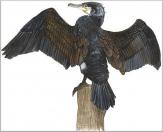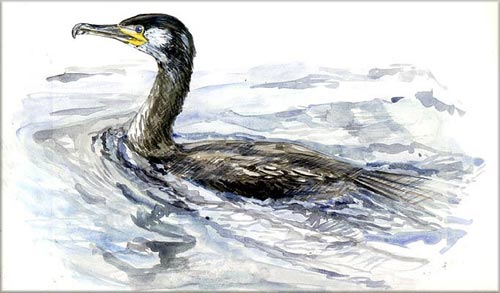Cormorant - Phalacrocorax carbo
Large water bird, bluish-black colour with white chin and cheeks.
The two sexes cannot be told apart but the juveniles can easily be recognised by their white underparts.
The continental sub-species can be distinguished from the Atlantic one by the more abundant white areas on the head and neck.
Its resting position is characteristic, with its wings held half open to dry its feathers after fishing, as is its V formation in great flocks in flight.
Sometimes it assumes a very low floating line, with just its neck and head held out of the water.
A gregarious species in all seasons, it nests in colonies on rocky shores along the coast, or on trees and shrubs in marshlands.
At its over-wintering sites it forms quite large dormitories, which often shelter groups coming from various feeding grounds.
Outside the breeding season, it frequents a wide range of wetlands as long as they are rich in fish and the water level is not too low.
Their basic diet consists of various species of fish they catch during the day by diving up to 10 metres deep. Until about ten years ago, Cormorants could sometimes be observed in inland Tuscany.
Today the species regularly over-winters along the River Arno Basin and over a hundred individuals daily use the Fucecchio Marshes Nature Reserve as their feeding ground.
Over the last few years, the species has begun to nest again in Peninsular Italy and since 2009 has been breeding at Fucecchio Marches.





